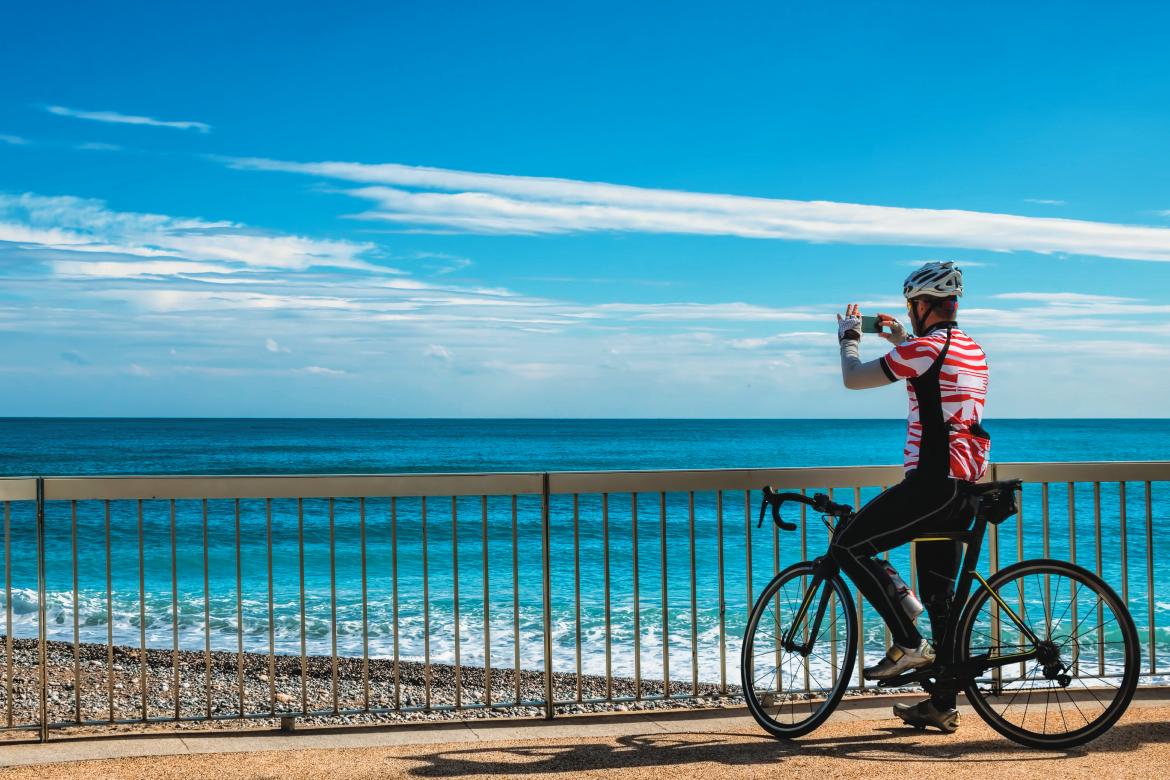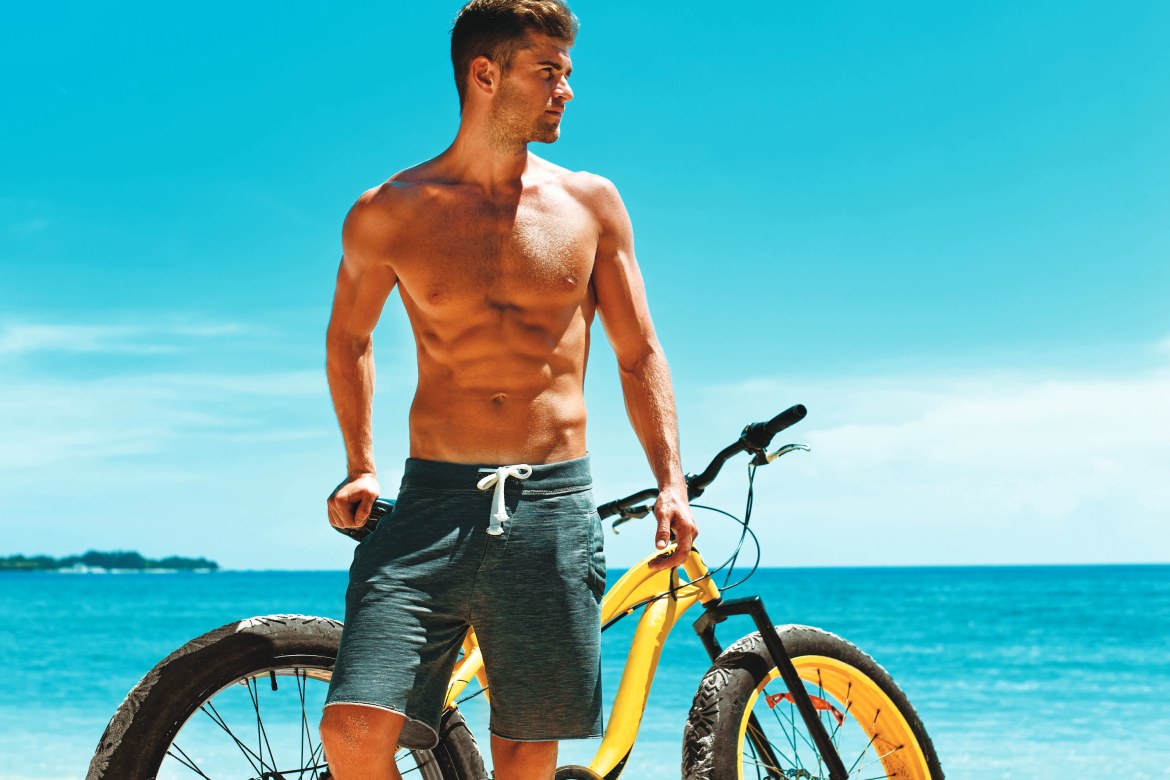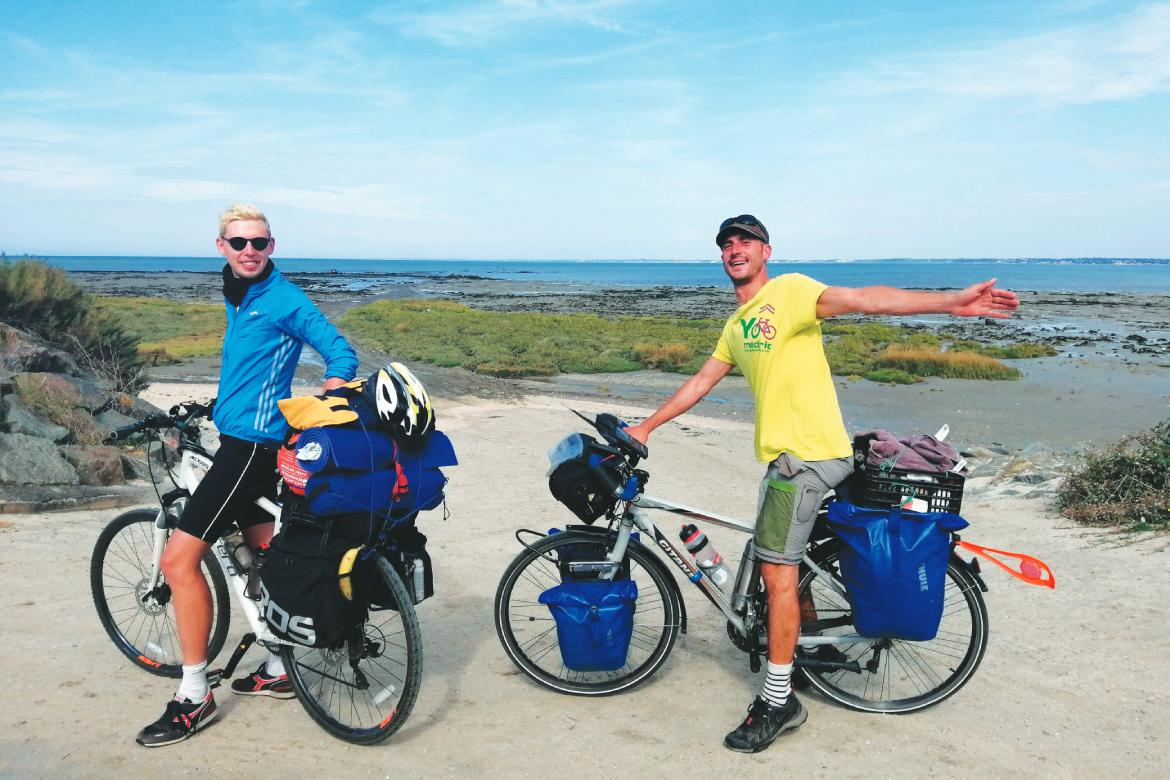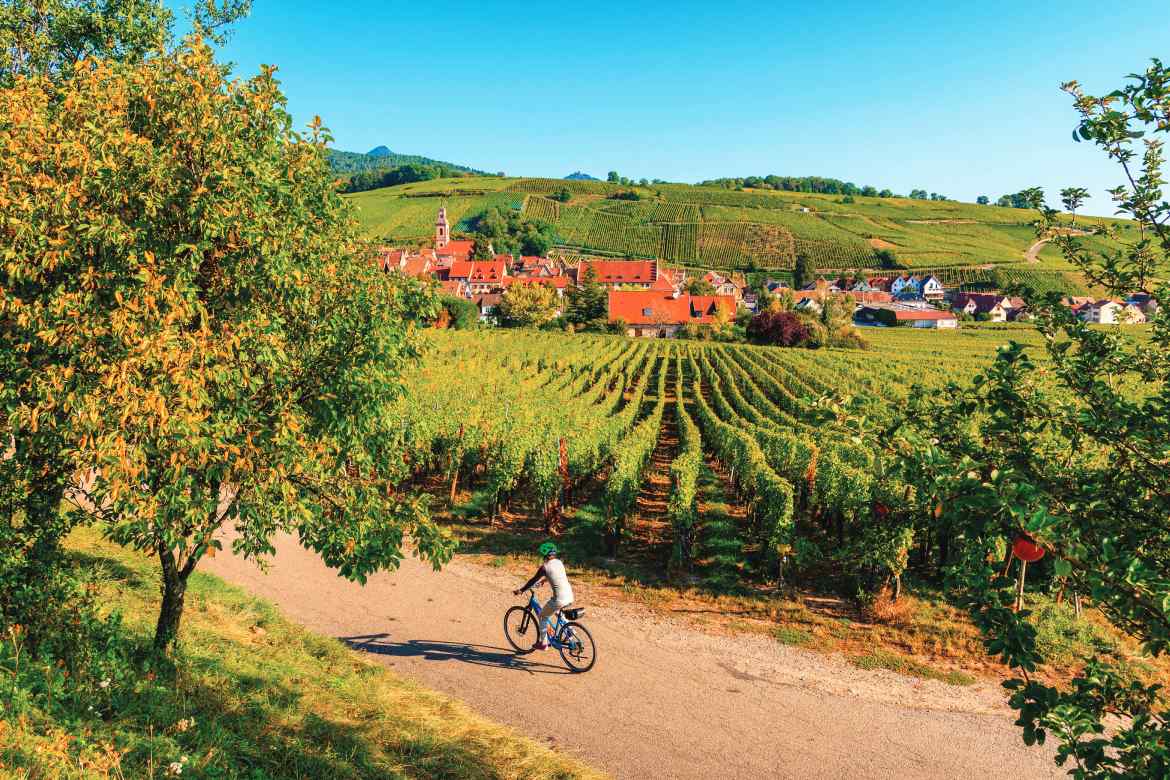
Let me start by saying that you don’t have to be an avid cyclist or an athlete to go on a long-distance cycling adventure.
That was certainly the case for me, before I set out on my epic cycling odyssey in September of 2019 I hadn’t even owned a bike in years. The summer which preceded my trip I had experienced a heightened feeling of restlessness, of longing for adventure. I wanted to hit the road, and since I don’t drive a bike seemed like a logical option. I use the word ‘logical’ loosely here, as nothing about that trip really made much sense, at least to no one other than myself.
France is the perfect destination for a cycling journey. There are many reasons for that, not the least of which is the fact that it’s an incredibly beautiful country. Since you will be spending many hours on your bike, taking in the scenery, it might be a good idea to pick somewhere that will provide an unforgettable feast for your eyes. Secondly, it’s very cyclist-friendly, with hundreds of miles of dedicated cycling routes and plenty more miles of quiet country roads and byways which are also relatively safe. I was completely unaware of any of that when I started my trip, which took me from my house in London all the way to the Spanish border; a six-week extravaganza that in many ways changed my life. I really had no expectations or ideas of what the journey would be like, and I think that’s possibly the best way to travel. There are certain things, however, which are probably worth knowing, and that I wish someone had told me before I so recklessly headed out into the unknown.
To begin with, assess how much time you’re willing to dedicate to this trip. If you have an unlimited amount of time, options are quite frankly endless. Anywhere under a week will require you to pick a more precise route, but that doesn’t mean that you won’t be able to wander spontaneously off your original path. Some of the most beautiful and unforgettable places and experiences will come upon you as a result of a wrong turn or an impulsive detour. You may also want to decide on the type of accommodation you want to stay at during your trip. In my case, I camped for almost the entirety of the six weeks, aside from a couple of rainy nights in a youth hostel in La Rochelle and a night in an Airbnb I shared with some friends I met on the road.

Menton, France (Photo by ArTono)
Perhaps somewhat surprisingly, camping sites in France are for the most part incredibly modern, and much more luxurious than I had imagined. Of course, this won’t be the case everywhere you go, and bear in mind that most camping sites are seasonal, operating between May and October. If you decide to make do with a tent as your home, you’ll be happy to know that in the majority of campsites you’ll have the option to shower, connect to electricity and Wi-Fi, do your laundry, and if you’re lucky, you’ll also have such facilities as swimming pools and restaurants at your disposal. Generally, it’s not necessary to plan and book your stops in advance, as most towns have at least one camping site. If you want to have a rough idea though, you can check out campingfrance.com for a complete list of all official campsites in France.
Another great aspect of cycling in France is the fact that most regional trains allow you to take your bike onboard free of charge, although in some cases you may want to book your space in advance, especially on the more popular routes, and in high season. This means that if you have time constraints or simply don’t feel like cycling for a thousand miles as I did, you can easily skip parts of your route and pick up your adventure elsewhere. And with a country as diverse and rich in natural beauty and cultural heritage, there is really no end to the various options.
Depending on your starting point, there are a number of excellent routes to consider, although, these are just suggestions, and you should always try to put a personal spin on any well-trotted path, allowing time for straying off and discovering the unexpected.

Cyclist on the Beach in France (Photo by Puhhha)
Starting in the north of the country, one of the most beautiful routes is the one which runs alongside the English Channel. Part of the EuroVelo 4 (en.eurovelo.com/ev4) international route, this stretch will take you through the historic beaches of Normandy, rocky cliffs and moody dunes. Perhaps the highlight of this part of France is the iconic Mont-Saint-Michel, a gothic abbey situated on a small island just off the Normandy coast, accessible only during low tide. This is an Instagrammer’s must-see and a good middle-point on the trip along the coast. You may want to stop here for a couple of days to rest and explore, before heading over to Brittany and meeting the Atlantic Ocean on the west corner of the country.
Another fantastic route is the Vélodyssée (cycling-lavelodyssee.com), which runs for over 700 miles along the Atlantic Coast, from the rocky shores of Brittany to the Pyrenees and the Spanish border in the south. Having cycled a vast majority of it myself, I can attest to the fact that it is a truly incredible journey, taking you through a variety of landscapes and distinct regional cultures. It was while cycling the Vélodyssée that I met my current boyfriend, and subsequently moved to France. There is something about passing small coastal villages and dreamy, laid-back surfing towns that appeals to my romantic nature. All you need is a Lana Del Rey playlist and some sunscreen, and you’re good to go.

Anthony and Flo Near La Rochelle (Photo by Miriam)
France is the perfect destination for a cycling journey.There are many reasons for that, not the least of which is the fact that it’s an incredibly beautiful country.
Some particular highlights on the way include the beautiful port city of La Rochelle, which offers some excellent restaurants and picturesque architecture, the upscale seaside resort of Arcachon and the nearby Dune du Pilat, Europe’s largest sand dune, and further down south the uber-cool surfer friendly Hossegor and the elegant cities of Bayonne and Biarritz. Naturally, you don’t have to cycle the entire length of the western coast to get a taste of it, and while less known than the French Riviera, this is arguably the most beautiful coast in France.
Another popular route, which affords you the chance to visit some of the breathtaking chateaux of the Loire River valley, is the area between the cities of Blois and Saumur (loirebybike.co.uk). The entire journey will take you around one week, during which, aside from the iconic castles and stately homes, you’ll be enchanted by the natural beauty of the region.

Cycling Trail and the Chateau of Josselin, Brittany, France (Photo by Pecold)
If you’re up for a longer adventure, you may choose to cycle the entire width of France along this same route, which is part of the longer EuroVelo 6. Starting on the Atlantic coast, at the mouth of the Loire, you’ll be able to enjoy an almost uninterrupted cyclist-friendly trail all the way to Strasbourg. Along the way, you’ll cycle alongside the Loire, the gorgeous canals of Burgundy, the valleys of Saone and Doubs rivers, and the Rhone-Rhine Canal.
One thing to note is that, while France is cyclist-friendly, there will be stretches of the road where you’ll have to cycle long distances without being able to seek help from a bike shop or a garage, which is why it’s always imperative to be well-stocked on all necessary cycling gear, including spare tires, inner tubes, and a pump. If you’re not an experienced cyclist, make sure to spend an evening watching YouTube tutorials on how to change a tire/inner tube. It might sound like an obvious thing, but you’d be surprised how many people I met on the road who didn’t possess those basic skills.

Cycling the Alsace Wine Route (Photo by Pawel Kazmierczak)
If you really want to challenge yourself, while also witnessing some of the most breathtaking vistas in Europe, you may want to take your bike to the mountainous trails of the Alps and the Pyrenees. This would require a more thorough preparation and physical training. I gave up on this journey just as I started approaching the beautiful Basque Country, where the Pyrenees meet the Atlantic Ocean. I simply knew that my bike and my body were not up to it, and it’s always safer to admit that to yourself than push ahead against your better judgement. If, however, you are a seasoned cyclist and own a good mountain bike, France is certainly one of the best destinations for high-altitude rides. Most mountain trails in France follow a color grading system, which will help you to establish the level of difficulty involved (check trailforks.com for all the routes).
Naturally, I have merely scratched the surface of all the possible routes and options here, as there are so many more to consider and explore. There’s picturesque Provence with its rolling hills and lavender fields, where you need to make sure to visit the iconic Mont Ventoux, a favourite destination for cyclists from all over the world. You may also opt for the old world glamor of the Cote d’Azur, with hundreds of miles of cyclist-friendly routes, although you have to keep in mind the steep climbs, as you’ll be at the foot of the Alps.
Wherever you decide to start, and however long you decide to go for, I can guarantee that you will have the time of your life. Be open, be friendly, and take it all in. You will learn new things about the world and about yourself, and who knows, if you’re lucky, you may even find a whole new direction in the process. I know I did.
You may also enjoy
Migrating For Love | Starting A New Life In France
France In A Glass
The post Pedaling Pleasure — The Best Places to Cycle in France appeared first on Passport Magazine.
Pedaling Pleasure — The Best Places to Cycle in France
Let me start by saying that you don’t have to be an avid cyclist or an athlete to go on a long-distance cycling adventure.
That was certainly the case for me, before I set out on my epic cycling odyssey in September of 2019 I hadn’t even owned a bike in years. The summer which preceded my trip I had experienced a heightened feeling of restlessness, of longing for adventure. I wanted to hit the road, and since I don’t drive a bike seemed like a logical option. I use the word ‘logical’ loosely here, as nothing about that trip really made much sense, at least to no one other than myself.
France is the perfect destination for a cycling journey. There are many reasons for that, not the least of which is the fact that it’s an incredibly beautiful country. Since you will be spending many hours on your bike, taking in the scenery, it might be a good idea to pick somewhere that will provide an unforgettable feast for your eyes. Secondly, it’s very cyclist-friendly, with hundreds of miles of dedicated cycling routes and plenty more miles of quiet country roads and byways which are also relatively safe. I was completely unaware of any of that when I started my trip, which took me from my house in London all the way to the Spanish border; a six-week extravaganza that in many ways changed my life. I really had no expectations or ideas of what the journey would be like, and I think that’s possibly the best way to travel. There are certain things, however, which are probably worth knowing, and that I wish someone had told me before I so recklessly headed out into the unknown.
To begin with, assess how much time you’re willing to dedicate to this trip. If you have an unlimited amount of time, options are quite frankly endless. Anywhere under a week will require you to pick a more precise route, but that doesn’t mean that you won’t be able to wander spontaneously off your original path. Some of the most beautiful and unforgettable places and experiences will come upon you as a result of a wrong turn or an impulsive detour. You may also want to decide on the type of accommodation you want to stay at during your trip. In my case, I camped for almost the entirety of the six weeks, aside from a couple of rainy nights in a youth hostel in La Rochelle and a night in an Airbnb I shared with some friends I met on the road.

Menton, France (Photo by ArTono)
Perhaps somewhat surprisingly, camping sites in France are for the most part incredibly modern, and much more luxurious than I had imagined. Of course, this won’t be the case everywhere you go, and bear in mind that most camping sites are seasonal, operating between May and October. If you decide to make do with a tent as your home, you’ll be happy to know that in the majority of campsites you’ll have the option to shower, connect to electricity and Wi-Fi, do your laundry, and if you’re lucky, you’ll also have such facilities as swimming pools and restaurants at your disposal. Generally, it’s not necessary to plan and book your stops in advance, as most towns have at least one camping site. If you want to have a rough idea though, you can check out campingfrance.com for a complete list of all official campsites in France.
Another great aspect of cycling in France is the fact that most regional trains allow you to take your bike onboard free of charge, although in some cases you may want to book your space in advance, especially on the more popular routes, and in high season. This means that if you have time constraints or simply don’t feel like cycling for a thousand miles as I did, you can easily skip parts of your route and pick up your adventure elsewhere. And with a country as diverse and rich in natural beauty and cultural heritage, there is really no end to the various options.
Depending on your starting point, there are a number of excellent routes to consider, although, these are just suggestions, and you should always try to put a personal spin on any well-trotted path, allowing time for straying off and discovering the unexpected.

Cyclist on the Beach in France (Photo by Puhhha)
Starting in the north of the country, one of the most beautiful routes is the one which runs alongside the English Channel. Part of the EuroVelo 4 (en.eurovelo.com/ev4) international route, this stretch will take you through the historic beaches of Normandy, rocky cliffs and moody dunes. Perhaps the highlight of this part of France is the iconic Mont-Saint-Michel, a gothic abbey situated on a small island just off the Normandy coast, accessible only during low tide. This is an Instagrammer’s must-see and a good middle-point on the trip along the coast. You may want to stop here for a couple of days to rest and explore, before heading over to Brittany and meeting the Atlantic Ocean on the west corner of the country.
Another fantastic route is the Vélodyssée (cycling-lavelodyssee.com), which runs for over 700 miles along the Atlantic Coast, from the rocky shores of Brittany to the Pyrenees and the Spanish border in the south. Having cycled a vast majority of it myself, I can attest to the fact that it is a truly incredible journey, taking you through a variety of landscapes and distinct regional cultures. It was while cycling the Vélodyssée that I met my current boyfriend, and subsequently moved to France. There is something about passing small coastal villages and dreamy, laid-back surfing towns that appeals to my romantic nature. All you need is a Lana Del Rey playlist and some sunscreen, and you’re good to go.

Anthony and Flo Near La Rochelle (Photo by Miriam)
France is the perfect destination for a cycling journey.There are many reasons for that, not the least of which is the fact that it’s an incredibly beautiful country.
Some particular highlights on the way include the beautiful port city of La Rochelle, which offers some excellent restaurants and picturesque architecture, the upscale seaside resort of Arcachon and the nearby Dune du Pilat, Europe’s largest sand dune, and further down south the uber-cool surfer friendly Hossegor and the elegant cities of Bayonne and Biarritz. Naturally, you don’t have to cycle the entire length of the western coast to get a taste of it, and while less known than the French Riviera, this is arguably the most beautiful coast in France.
Another popular route, which affords you the chance to visit some of the breathtaking chateaux of the Loire River valley, is the area between the cities of Blois and Saumur (loirebybike.co.uk). The entire journey will take you around one week, during which, aside from the iconic castles and stately homes, you’ll be enchanted by the natural beauty of the region.

Cycling Trail and the Chateau of Josselin, Brittany, France (Photo by Pecold)
If you’re up for a longer adventure, you may choose to cycle the entire width of France along this same route, which is part of the longer EuroVelo 6. Starting on the Atlantic coast, at the mouth of the Loire, you’ll be able to enjoy an almost uninterrupted cyclist-friendly trail all the way to Strasbourg. Along the way, you’ll cycle alongside the Loire, the gorgeous canals of Burgundy, the valleys of Saone and Doubs rivers, and the Rhone-Rhine Canal.
One thing to note is that, while France is cyclist-friendly, there will be stretches of the road where you’ll have to cycle long distances without being able to seek help from a bike shop or a garage, which is why it’s always imperative to be well-stocked on all necessary cycling gear, including spare tires, inner tubes, and a pump. If you’re not an experienced cyclist, make sure to spend an evening watching YouTube tutorials on how to change a tire/inner tube. It might sound like an obvious thing, but you’d be surprised how many people I met on the road who didn’t possess those basic skills.

Cycling the Alsace Wine Route (Photo by Pawel Kazmierczak)
If you really want to challenge yourself, while also witnessing some of the most breathtaking vistas in Europe, you may want to take your bike to the mountainous trails of the Alps and the Pyrenees. This would require a more thorough preparation and physical training. I gave up on this journey just as I started approaching the beautiful Basque Country, where the Pyrenees meet the Atlantic Ocean. I simply knew that my bike and my body were not up to it, and it’s always safer to admit that to yourself than push ahead against your better judgement. If, however, you are a seasoned cyclist and own a good mountain bike, France is certainly one of the best destinations for high-altitude rides. Most mountain trails in France follow a color grading system, which will help you to establish the level of difficulty involved (check trailforks.com for all the routes).
Naturally, I have merely scratched the surface of all the possible routes and options here, as there are so many more to consider and explore. There’s picturesque Provence with its rolling hills and lavender fields, where you need to make sure to visit the iconic Mont Ventoux, a favourite destination for cyclists from all over the world. You may also opt for the old world glamor of the Cote d’Azur, with hundreds of miles of cyclist-friendly routes, although you have to keep in mind the steep climbs, as you’ll be at the foot of the Alps.
Wherever you decide to start, and however long you decide to go for, I can guarantee that you will have the time of your life. Be open, be friendly, and take it all in. You will learn new things about the world and about yourself, and who knows, if you’re lucky, you may even find a whole new direction in the process. I know I did.
You may also enjoy
Migrating For Love | Starting A New Life In France
France In A Glass
The post Pedaling Pleasure — The Best Places to Cycle in France appeared first on Passport Magazine.


Post a Comment